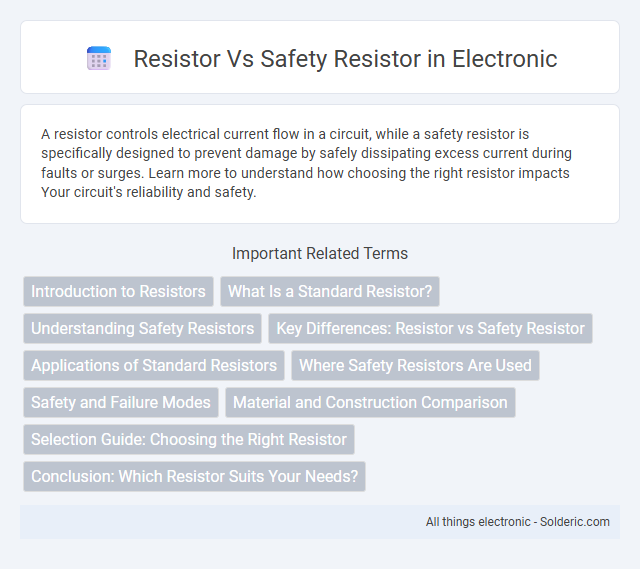A resistor controls electrical current flow in a circuit, while a safety resistor is specifically designed to prevent damage by safely dissipating excess current during faults or surges. Learn more to understand how choosing the right resistor impacts Your circuit's reliability and safety.
Comparison Table
| Feature | Resistor | Safety Resistor |
|---|---|---|
| Purpose | Limits current and divides voltage in circuits. | Protects circuits by preventing excessive current and voltage spikes. |
| Design | Standard resistive element material (carbon film, metal film). | Designed with higher power rating and flame-retardant casing. |
| Power Rating | Varies, typically 0.1W to 5W. | Higher power rating, often above 5W for better durability. |
| Safety Features | Basic thermal and electrical characteristics. | Includes thermal fusible elements or thermal shut-down properties. |
| Applications | General electronics, signal processing, load handling. | Power supplies, surge protection, high-risk environments. |
| Failure Mode | May burn out or short circuit under overload. | Fails open to protect circuit, minimizing fire risk. |
Introduction to Resistors
Resistors are fundamental electrical components that limit current flow and divide voltage in circuits, ensuring device functionality and protection. Safety resistors are specialized resistors designed with high power ratings and robust construction to prevent overheating and fire hazards under fault conditions. Your choice between standard and safety resistors depends on the application's reliability requirements and safety standards.
What Is a Standard Resistor?
A standard resistor is an electronic component designed to provide a precise resistance value to control current in a circuit, typically made from carbon film, metal film, or wire wound materials. Its primary function is to limit or regulate current flow while dissipating power as heat within specified tolerance and power ratings. Unlike safety resistors, standard resistors may not have enhanced features such as flame retardance or failure mode protection for critical safety applications.
Understanding Safety Resistors
Safety resistors are specially designed resistors that prevent dangerous currents or voltages in electronic circuits, enhancing overall protection. Unlike standard resistors, they feature higher power ratings, thermal stability, and compliance with safety standards like IEC 60384-14. Understanding safety resistors is crucial for ensuring Your electronic designs can withstand fault conditions without causing harm or equipment damage.
Key Differences: Resistor vs Safety Resistor
Resistors regulate electrical current by providing a specific resistance value to control circuit operations, while safety resistors are designed with materials and coatings that prevent fire hazards and withstand higher fault conditions. Safety resistors have enhanced power ratings and tolerance to heat to ensure circuit protection during overloads or short circuits, unlike standard resistors primarily focused on precise resistance performance. Key differences include safety resistors' fire-retardant properties and robustness for fail-safe applications in high-risk environments.
Applications of Standard Resistors
Standard resistors are widely used in electronic circuits for current limiting, voltage division, and signal conditioning in devices such as amplifiers, sensors, and microcontrollers. These resistors ensure precise control of electrical parameters, making them essential in consumer electronics, automotive systems, and industrial equipment. Their stable performance under typical operating conditions enables efficient circuit design and reliable operation across various applications.
Where Safety Resistors Are Used
Safety resistors are primarily used in electrical circuits requiring reliable current limitation to prevent overheating and potential fire hazards. These resistors are commonly found in appliances, industrial equipment, and automotive systems where enhanced safety standards must be met. Your electronic designs can benefit from safety resistors by ensuring compliance with stringent safety regulations and protecting both components and users.
Safety and Failure Modes
Safety resistors are specifically designed to withstand higher thermal and electrical stress, minimizing the risk of fire or explosion during failure compared to standard resistors. They incorporate non-flammable materials and produce predictable failure modes, such as open circuits, to prevent cascading damage in electronic circuits. In contrast, standard resistors may fail unpredictably, potentially causing short circuits or hazardous conditions in critical safety applications.
Material and Construction Comparison
Resistors are typically made from materials like carbon film, metal oxide, or wire-wound metals designed to provide precise resistance values, while safety resistors often use flame-retardant materials and are constructed with enhanced insulation to prevent fire hazards. The construction of safety resistors includes a robust casing and thermal protection features to withstand higher fault currents and extreme conditions, unlike standard resistors which prioritize electrical performance. Understanding the material and build differences helps you select components that ensure both circuit functionality and safety compliance.
Selection Guide: Choosing the Right Resistor
Selecting the right resistor involves considering factors such as power rating, resistance tolerance, and thermal stability, which are crucial for ensuring circuit reliability. Safety resistors offer enhanced flame-retardant materials and fail-safe characteristics, making them ideal for applications requiring high safety standards like power supplies and medical devices. Prioritize safety resistors in environments prone to overheating or electrical faults to minimize fire hazards and ensure compliance with safety certifications.
Conclusion: Which Resistor Suits Your Needs?
Choosing between a resistor and a safety resistor depends on the specific application requirements; standard resistors provide general current control and voltage division, while safety resistors are designed to meet stringent standards like IEC 60384-14 for enhanced reliability under fault conditions. Safety resistors offer increased power dissipation, flame retardancy, and low thermal EMF, making them ideal for critical circuits in medical, industrial, and automotive electronics. Evaluating factors such as operating environment, failure mode tolerance, and regulatory compliance ensures the optimal resistor selection for both performance and safety.
resistor vs safety resistor Infographic

 solderic.com
solderic.com